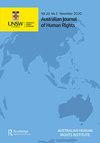Deciphering Australia’s encryption laws: a human rights approach
Q1 Arts and Humanities
引用次数: 0
Abstract
ABSTRACT New and emerging technologies bring both challenges and opportunities for human rights and society more broadly. This article argues that governments should take a human rights focused approach in responding to the challenges posed by new technologies. Encryption provides a pertinent example of this. After demonstrating that the right to privacy applies in the digital world, this article discusses the importance of encryption in securing privacy in digital contexts. The benefits of encryption are, however, weighed against its potential misuse for crime and other malicious purposes. In an attempt to regulate this potential misuse, Australia introduced the Telecommunications and Other Legislation Amendment (Assistance and Access) Act 2018 (Cth). Considering new data on the operation of the legislation since its commencement, this article assesses the compatibility of the regime with Australia’s international human rights obligations with respect to the right to privacy under the International Covenant on Civil and Political Rights. In doing so, this article demonstrates that key concerns around proportionality remain, making the Assistance and Access Act unlikely to be a permissible limitation on the right to privacy.解读澳大利亚加密法:一种人权途径
摘要:新兴技术为人权和更广泛的社会带来了挑战和机遇。这篇文章认为,各国政府在应对新技术带来的挑战时,应该采取以人权为重点的方法。加密提供了一个相关的例子。在证明隐私权适用于数字世界之后,本文讨论了加密在数字环境中保护隐私的重要性。然而,加密的好处与它可能被滥用用于犯罪和其他恶意目的相权衡。为了规范这种潜在的滥用,澳大利亚出台了《2018年电信和其他立法修正案(援助和接入)法》(Cth)。考虑到该立法自生效以来运作的新数据,本条评估了该制度是否符合澳大利亚在《公民权利和政治权利国际公约》规定的隐私权方面的国际人权义务。在这样做的过程中,这篇文章表明,关于相称性的关键问题仍然存在,这使得《援助和访问法》不太可能成为对隐私权的允许限制。
本文章由计算机程序翻译,如有差异,请以英文原文为准。
求助全文
约1分钟内获得全文
求助全文
来源期刊

Australian Journal of Human Rights
Arts and Humanities-History
CiteScore
1.30
自引率
0.00%
发文量
43
期刊介绍:
The Australian Journal of Human Rights (AJHR) is Australia’s first peer reviewed journal devoted exclusively to human rights development in Australia, the Asia-Pacific region and internationally. The journal aims to raise awareness of human rights issues in Australia and the Asia-Pacific region by providing a forum for scholarship and discussion. The AJHR examines legal aspects of human rights, along with associated philosophical, historical, economic and political considerations, across a range of issues, including aboriginal ownership of land, racial discrimination and vilification, human rights in the criminal justice system, children’s rights, homelessness, immigration, asylum and detention, corporate accountability, disability standards and free speech.
 求助内容:
求助内容: 应助结果提醒方式:
应助结果提醒方式:


